Auditor’s Report
VerifiedAdded on 2023/04/03
|14
|3142
|382
AI Summary
An analysis of a recent audit negligence case to determine the responsibility of the auditor and whether the auditor was actually negligent in the case.
Contribute Materials
Your contribution can guide someone’s learning journey. Share your
documents today.
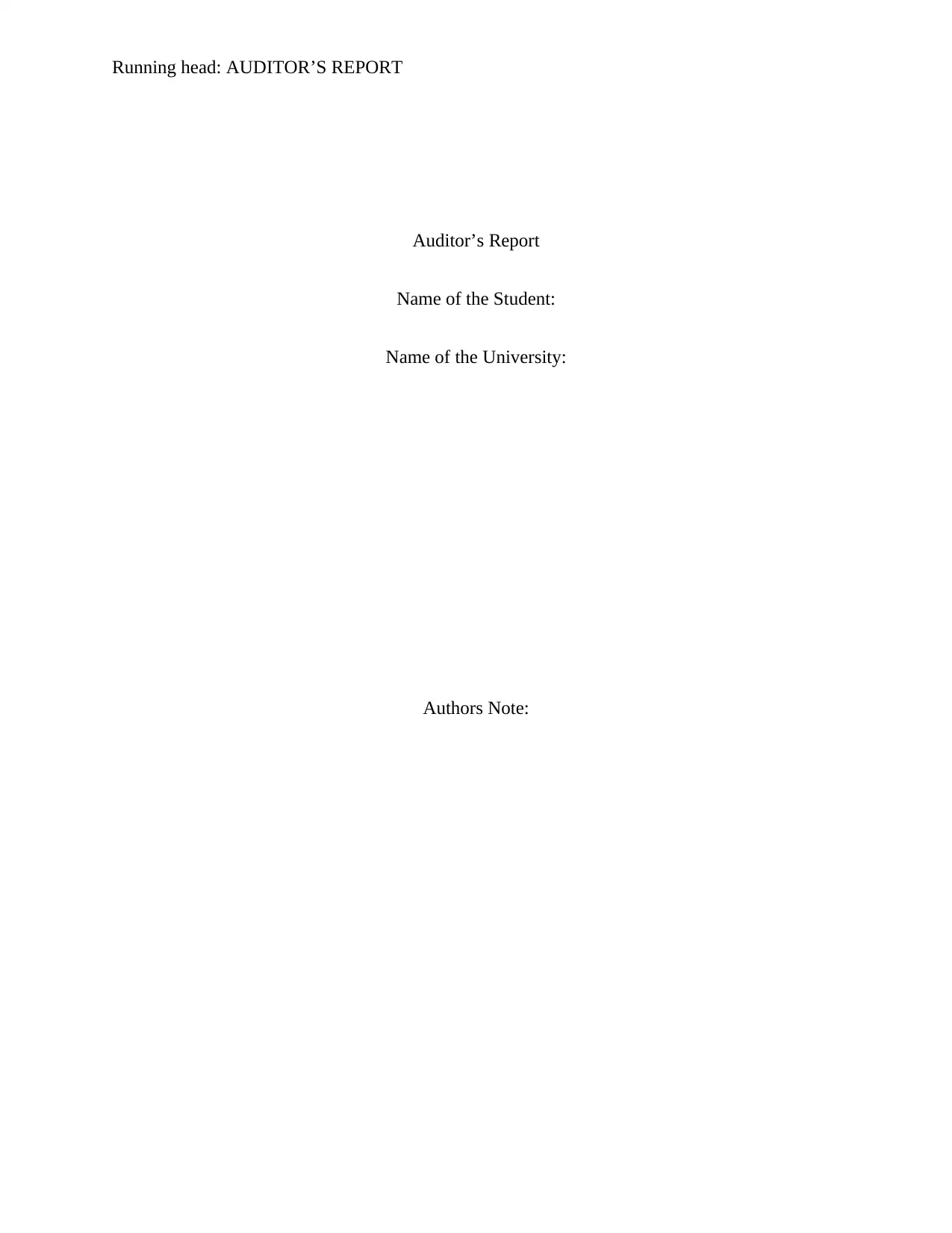
Running head: AUDITOR’S REPORT
Auditor’s Report
Name of the Student:
Name of the University:
Authors Note:
Auditor’s Report
Name of the Student:
Name of the University:
Authors Note:
Secure Best Marks with AI Grader
Need help grading? Try our AI Grader for instant feedback on your assignments.
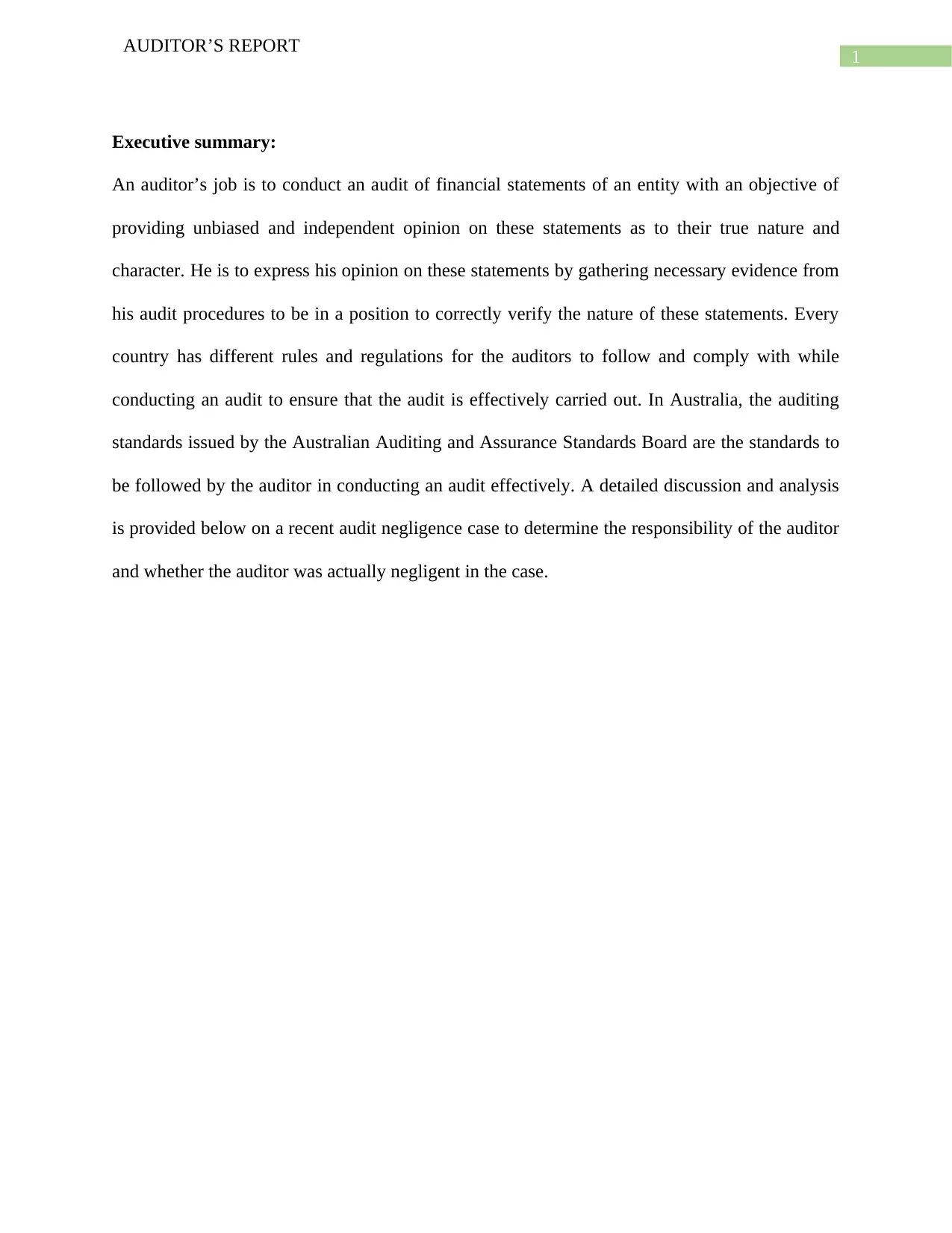
1
AUDITOR’S REPORT
Executive summary:
An auditor’s job is to conduct an audit of financial statements of an entity with an objective of
providing unbiased and independent opinion on these statements as to their true nature and
character. He is to express his opinion on these statements by gathering necessary evidence from
his audit procedures to be in a position to correctly verify the nature of these statements. Every
country has different rules and regulations for the auditors to follow and comply with while
conducting an audit to ensure that the audit is effectively carried out. In Australia, the auditing
standards issued by the Australian Auditing and Assurance Standards Board are the standards to
be followed by the auditor in conducting an audit effectively. A detailed discussion and analysis
is provided below on a recent audit negligence case to determine the responsibility of the auditor
and whether the auditor was actually negligent in the case.
AUDITOR’S REPORT
Executive summary:
An auditor’s job is to conduct an audit of financial statements of an entity with an objective of
providing unbiased and independent opinion on these statements as to their true nature and
character. He is to express his opinion on these statements by gathering necessary evidence from
his audit procedures to be in a position to correctly verify the nature of these statements. Every
country has different rules and regulations for the auditors to follow and comply with while
conducting an audit to ensure that the audit is effectively carried out. In Australia, the auditing
standards issued by the Australian Auditing and Assurance Standards Board are the standards to
be followed by the auditor in conducting an audit effectively. A detailed discussion and analysis
is provided below on a recent audit negligence case to determine the responsibility of the auditor
and whether the auditor was actually negligent in the case.
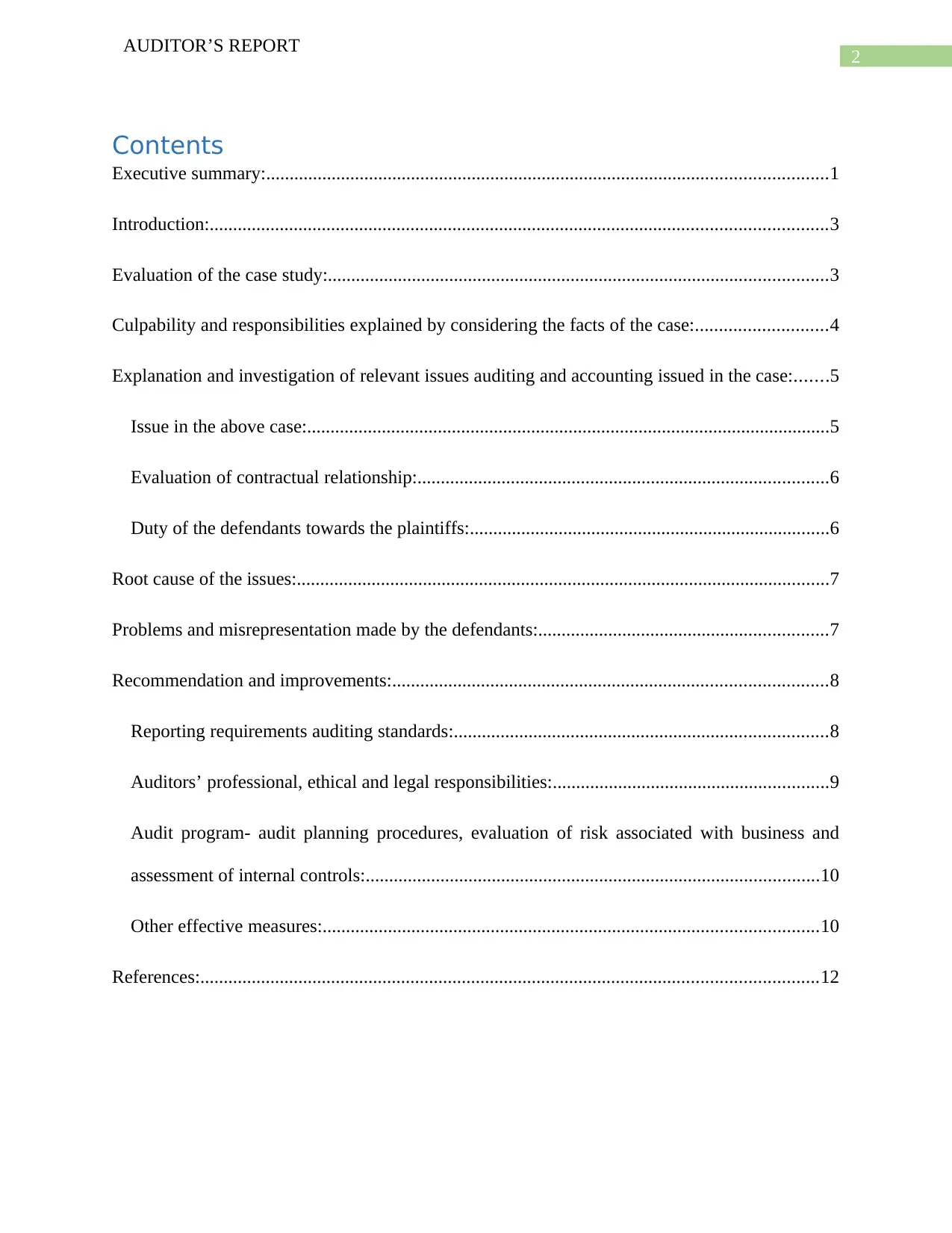
2
AUDITOR’S REPORT
Contents
Executive summary:........................................................................................................................1
Introduction:....................................................................................................................................3
Evaluation of the case study:...........................................................................................................3
Culpability and responsibilities explained by considering the facts of the case:............................4
Explanation and investigation of relevant issues auditing and accounting issued in the case:.......5
Issue in the above case:................................................................................................................5
Evaluation of contractual relationship:........................................................................................6
Duty of the defendants towards the plaintiffs:.............................................................................6
Root cause of the issues:..................................................................................................................7
Problems and misrepresentation made by the defendants:..............................................................7
Recommendation and improvements:.............................................................................................8
Reporting requirements auditing standards:................................................................................8
Auditors’ professional, ethical and legal responsibilities:...........................................................9
Audit program- audit planning procedures, evaluation of risk associated with business and
assessment of internal controls:.................................................................................................10
Other effective measures:..........................................................................................................10
References:....................................................................................................................................12
AUDITOR’S REPORT
Contents
Executive summary:........................................................................................................................1
Introduction:....................................................................................................................................3
Evaluation of the case study:...........................................................................................................3
Culpability and responsibilities explained by considering the facts of the case:............................4
Explanation and investigation of relevant issues auditing and accounting issued in the case:.......5
Issue in the above case:................................................................................................................5
Evaluation of contractual relationship:........................................................................................6
Duty of the defendants towards the plaintiffs:.............................................................................6
Root cause of the issues:..................................................................................................................7
Problems and misrepresentation made by the defendants:..............................................................7
Recommendation and improvements:.............................................................................................8
Reporting requirements auditing standards:................................................................................8
Auditors’ professional, ethical and legal responsibilities:...........................................................9
Audit program- audit planning procedures, evaluation of risk associated with business and
assessment of internal controls:.................................................................................................10
Other effective measures:..........................................................................................................10
References:....................................................................................................................................12
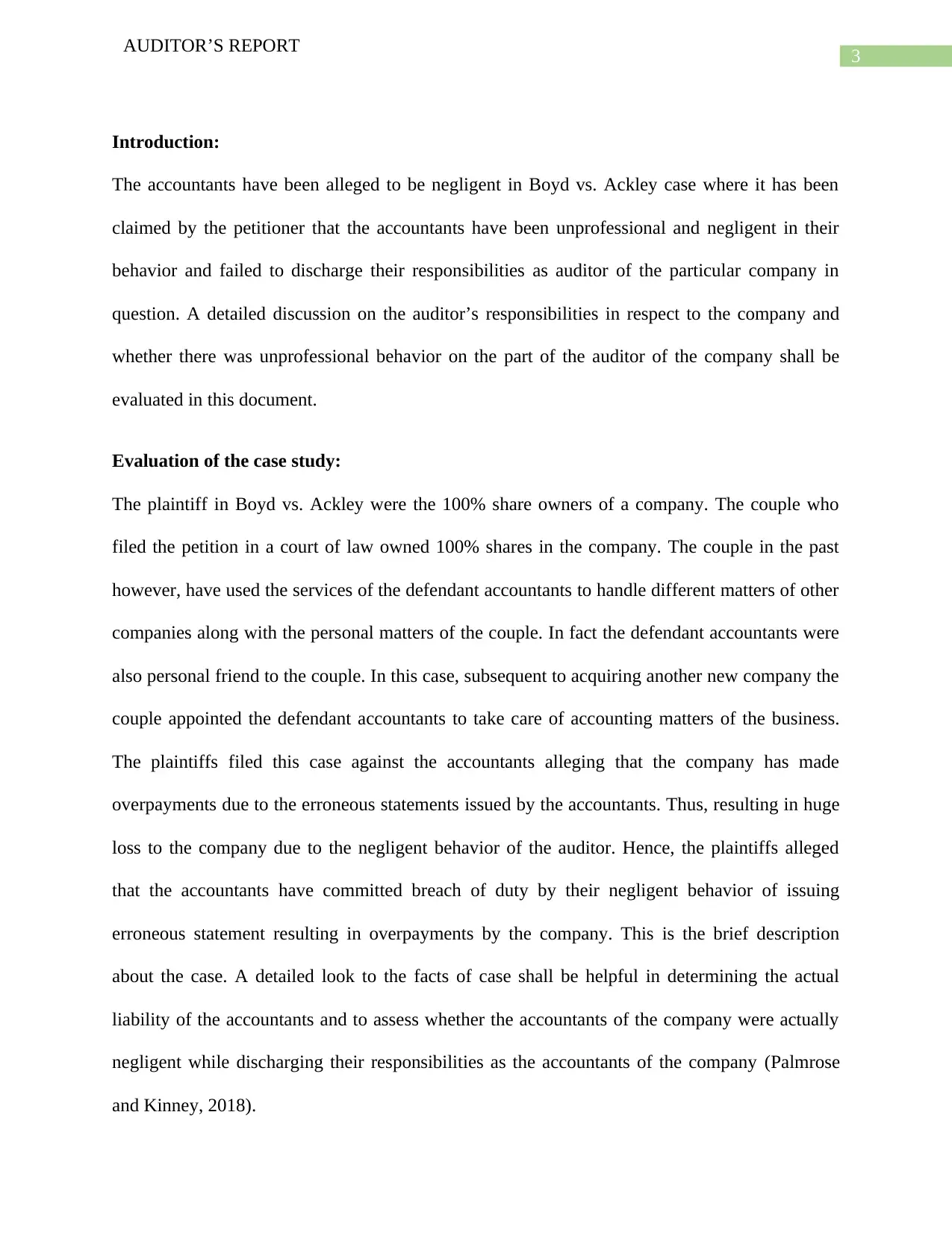
3
AUDITOR’S REPORT
Introduction:
The accountants have been alleged to be negligent in Boyd vs. Ackley case where it has been
claimed by the petitioner that the accountants have been unprofessional and negligent in their
behavior and failed to discharge their responsibilities as auditor of the particular company in
question. A detailed discussion on the auditor’s responsibilities in respect to the company and
whether there was unprofessional behavior on the part of the auditor of the company shall be
evaluated in this document.
Evaluation of the case study:
The plaintiff in Boyd vs. Ackley were the 100% share owners of a company. The couple who
filed the petition in a court of law owned 100% shares in the company. The couple in the past
however, have used the services of the defendant accountants to handle different matters of other
companies along with the personal matters of the couple. In fact the defendant accountants were
also personal friend to the couple. In this case, subsequent to acquiring another new company the
couple appointed the defendant accountants to take care of accounting matters of the business.
The plaintiffs filed this case against the accountants alleging that the company has made
overpayments due to the erroneous statements issued by the accountants. Thus, resulting in huge
loss to the company due to the negligent behavior of the auditor. Hence, the plaintiffs alleged
that the accountants have committed breach of duty by their negligent behavior of issuing
erroneous statement resulting in overpayments by the company. This is the brief description
about the case. A detailed look to the facts of case shall be helpful in determining the actual
liability of the accountants and to assess whether the accountants of the company were actually
negligent while discharging their responsibilities as the accountants of the company (Palmrose
and Kinney, 2018).
AUDITOR’S REPORT
Introduction:
The accountants have been alleged to be negligent in Boyd vs. Ackley case where it has been
claimed by the petitioner that the accountants have been unprofessional and negligent in their
behavior and failed to discharge their responsibilities as auditor of the particular company in
question. A detailed discussion on the auditor’s responsibilities in respect to the company and
whether there was unprofessional behavior on the part of the auditor of the company shall be
evaluated in this document.
Evaluation of the case study:
The plaintiff in Boyd vs. Ackley were the 100% share owners of a company. The couple who
filed the petition in a court of law owned 100% shares in the company. The couple in the past
however, have used the services of the defendant accountants to handle different matters of other
companies along with the personal matters of the couple. In fact the defendant accountants were
also personal friend to the couple. In this case, subsequent to acquiring another new company the
couple appointed the defendant accountants to take care of accounting matters of the business.
The plaintiffs filed this case against the accountants alleging that the company has made
overpayments due to the erroneous statements issued by the accountants. Thus, resulting in huge
loss to the company due to the negligent behavior of the auditor. Hence, the plaintiffs alleged
that the accountants have committed breach of duty by their negligent behavior of issuing
erroneous statement resulting in overpayments by the company. This is the brief description
about the case. A detailed look to the facts of case shall be helpful in determining the actual
liability of the accountants and to assess whether the accountants of the company were actually
negligent while discharging their responsibilities as the accountants of the company (Palmrose
and Kinney, 2018).
Secure Best Marks with AI Grader
Need help grading? Try our AI Grader for instant feedback on your assignments.
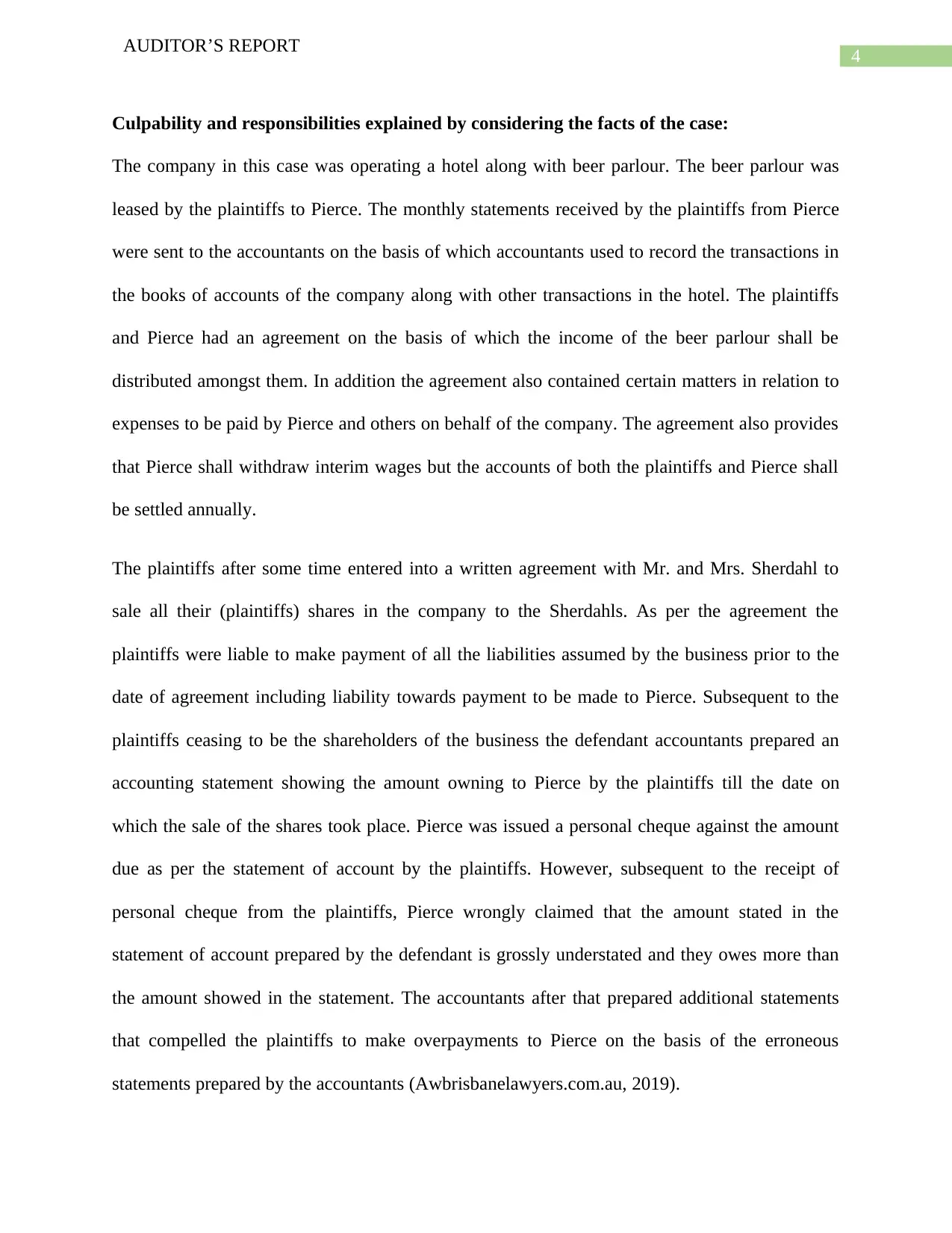
4
AUDITOR’S REPORT
Culpability and responsibilities explained by considering the facts of the case:
The company in this case was operating a hotel along with beer parlour. The beer parlour was
leased by the plaintiffs to Pierce. The monthly statements received by the plaintiffs from Pierce
were sent to the accountants on the basis of which accountants used to record the transactions in
the books of accounts of the company along with other transactions in the hotel. The plaintiffs
and Pierce had an agreement on the basis of which the income of the beer parlour shall be
distributed amongst them. In addition the agreement also contained certain matters in relation to
expenses to be paid by Pierce and others on behalf of the company. The agreement also provides
that Pierce shall withdraw interim wages but the accounts of both the plaintiffs and Pierce shall
be settled annually.
The plaintiffs after some time entered into a written agreement with Mr. and Mrs. Sherdahl to
sale all their (plaintiffs) shares in the company to the Sherdahls. As per the agreement the
plaintiffs were liable to make payment of all the liabilities assumed by the business prior to the
date of agreement including liability towards payment to be made to Pierce. Subsequent to the
plaintiffs ceasing to be the shareholders of the business the defendant accountants prepared an
accounting statement showing the amount owning to Pierce by the plaintiffs till the date on
which the sale of the shares took place. Pierce was issued a personal cheque against the amount
due as per the statement of account by the plaintiffs. However, subsequent to the receipt of
personal cheque from the plaintiffs, Pierce wrongly claimed that the amount stated in the
statement of account prepared by the defendant is grossly understated and they owes more than
the amount showed in the statement. The accountants after that prepared additional statements
that compelled the plaintiffs to make overpayments to Pierce on the basis of the erroneous
statements prepared by the accountants (Awbrisbanelawyers.com.au, 2019).
AUDITOR’S REPORT
Culpability and responsibilities explained by considering the facts of the case:
The company in this case was operating a hotel along with beer parlour. The beer parlour was
leased by the plaintiffs to Pierce. The monthly statements received by the plaintiffs from Pierce
were sent to the accountants on the basis of which accountants used to record the transactions in
the books of accounts of the company along with other transactions in the hotel. The plaintiffs
and Pierce had an agreement on the basis of which the income of the beer parlour shall be
distributed amongst them. In addition the agreement also contained certain matters in relation to
expenses to be paid by Pierce and others on behalf of the company. The agreement also provides
that Pierce shall withdraw interim wages but the accounts of both the plaintiffs and Pierce shall
be settled annually.
The plaintiffs after some time entered into a written agreement with Mr. and Mrs. Sherdahl to
sale all their (plaintiffs) shares in the company to the Sherdahls. As per the agreement the
plaintiffs were liable to make payment of all the liabilities assumed by the business prior to the
date of agreement including liability towards payment to be made to Pierce. Subsequent to the
plaintiffs ceasing to be the shareholders of the business the defendant accountants prepared an
accounting statement showing the amount owning to Pierce by the plaintiffs till the date on
which the sale of the shares took place. Pierce was issued a personal cheque against the amount
due as per the statement of account by the plaintiffs. However, subsequent to the receipt of
personal cheque from the plaintiffs, Pierce wrongly claimed that the amount stated in the
statement of account prepared by the defendant is grossly understated and they owes more than
the amount showed in the statement. The accountants after that prepared additional statements
that compelled the plaintiffs to make overpayments to Pierce on the basis of the erroneous
statements prepared by the accountants (Awbrisbanelawyers.com.au, 2019).
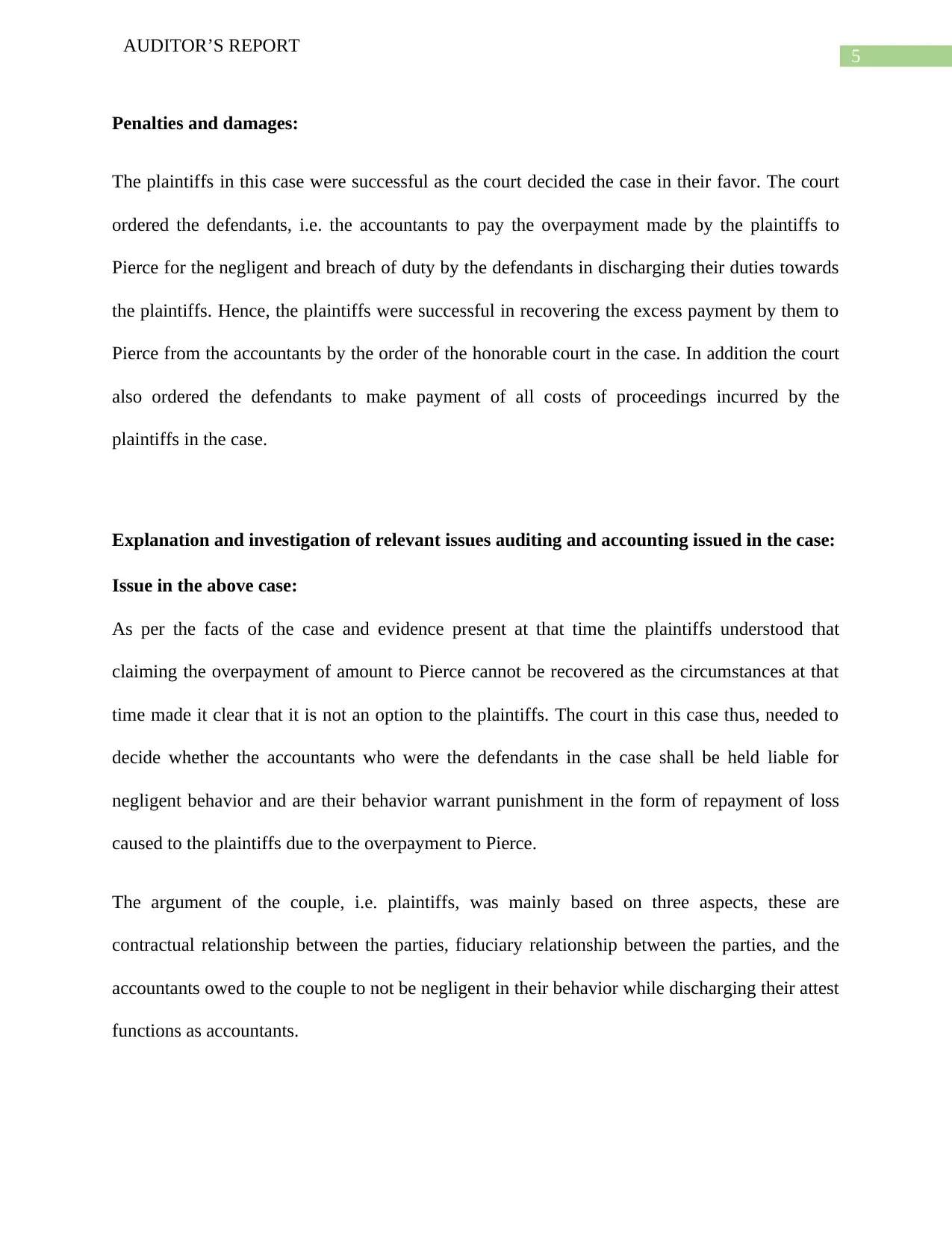
5
AUDITOR’S REPORT
Penalties and damages:
The plaintiffs in this case were successful as the court decided the case in their favor. The court
ordered the defendants, i.e. the accountants to pay the overpayment made by the plaintiffs to
Pierce for the negligent and breach of duty by the defendants in discharging their duties towards
the plaintiffs. Hence, the plaintiffs were successful in recovering the excess payment by them to
Pierce from the accountants by the order of the honorable court in the case. In addition the court
also ordered the defendants to make payment of all costs of proceedings incurred by the
plaintiffs in the case.
Explanation and investigation of relevant issues auditing and accounting issued in the case:
Issue in the above case:
As per the facts of the case and evidence present at that time the plaintiffs understood that
claiming the overpayment of amount to Pierce cannot be recovered as the circumstances at that
time made it clear that it is not an option to the plaintiffs. The court in this case thus, needed to
decide whether the accountants who were the defendants in the case shall be held liable for
negligent behavior and are their behavior warrant punishment in the form of repayment of loss
caused to the plaintiffs due to the overpayment to Pierce.
The argument of the couple, i.e. plaintiffs, was mainly based on three aspects, these are
contractual relationship between the parties, fiduciary relationship between the parties, and the
accountants owed to the couple to not be negligent in their behavior while discharging their attest
functions as accountants.
AUDITOR’S REPORT
Penalties and damages:
The plaintiffs in this case were successful as the court decided the case in their favor. The court
ordered the defendants, i.e. the accountants to pay the overpayment made by the plaintiffs to
Pierce for the negligent and breach of duty by the defendants in discharging their duties towards
the plaintiffs. Hence, the plaintiffs were successful in recovering the excess payment by them to
Pierce from the accountants by the order of the honorable court in the case. In addition the court
also ordered the defendants to make payment of all costs of proceedings incurred by the
plaintiffs in the case.
Explanation and investigation of relevant issues auditing and accounting issued in the case:
Issue in the above case:
As per the facts of the case and evidence present at that time the plaintiffs understood that
claiming the overpayment of amount to Pierce cannot be recovered as the circumstances at that
time made it clear that it is not an option to the plaintiffs. The court in this case thus, needed to
decide whether the accountants who were the defendants in the case shall be held liable for
negligent behavior and are their behavior warrant punishment in the form of repayment of loss
caused to the plaintiffs due to the overpayment to Pierce.
The argument of the couple, i.e. plaintiffs, was mainly based on three aspects, these are
contractual relationship between the parties, fiduciary relationship between the parties, and the
accountants owed to the couple to not be negligent in their behavior while discharging their attest
functions as accountants.
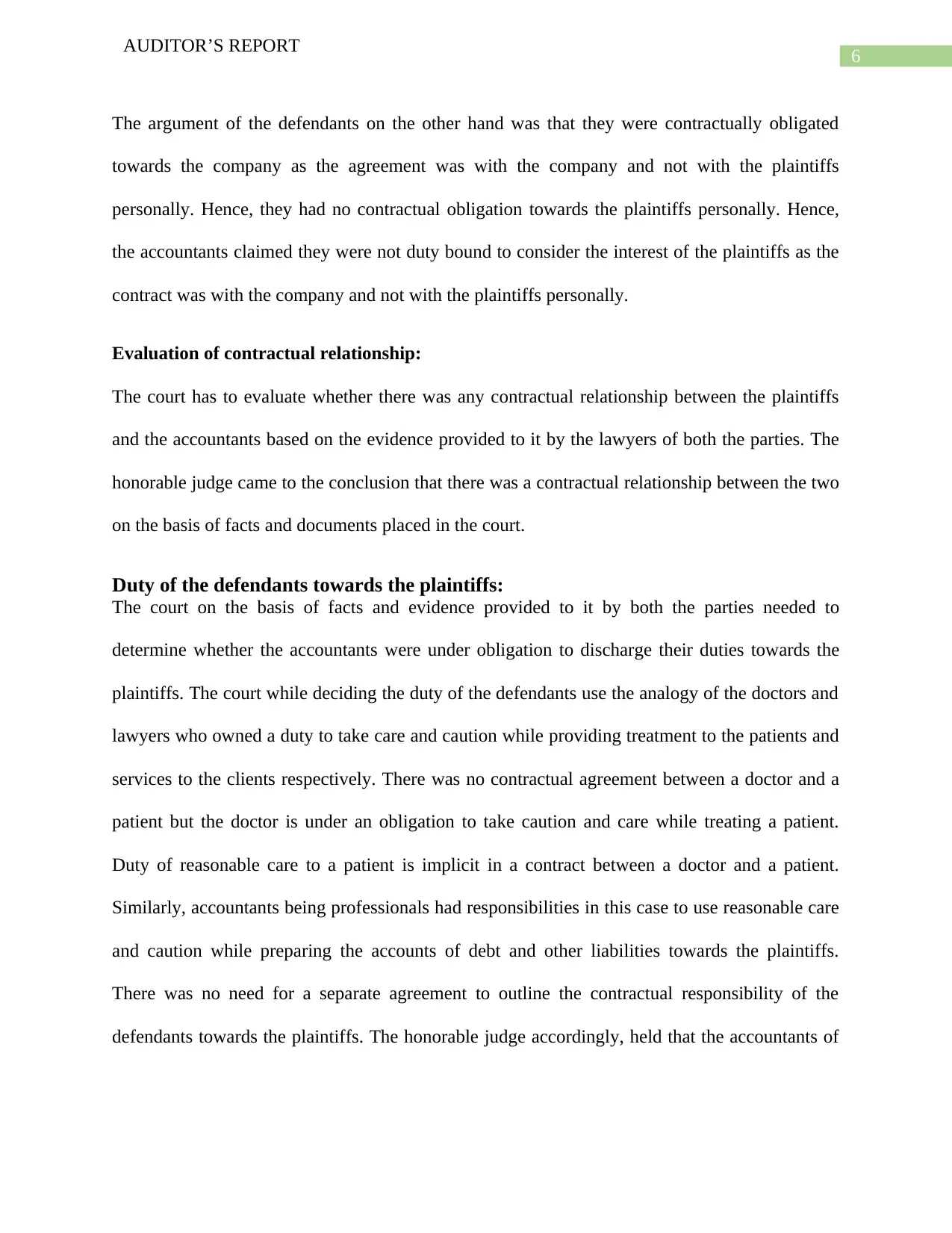
6
AUDITOR’S REPORT
The argument of the defendants on the other hand was that they were contractually obligated
towards the company as the agreement was with the company and not with the plaintiffs
personally. Hence, they had no contractual obligation towards the plaintiffs personally. Hence,
the accountants claimed they were not duty bound to consider the interest of the plaintiffs as the
contract was with the company and not with the plaintiffs personally.
Evaluation of contractual relationship:
The court has to evaluate whether there was any contractual relationship between the plaintiffs
and the accountants based on the evidence provided to it by the lawyers of both the parties. The
honorable judge came to the conclusion that there was a contractual relationship between the two
on the basis of facts and documents placed in the court.
Duty of the defendants towards the plaintiffs:
The court on the basis of facts and evidence provided to it by both the parties needed to
determine whether the accountants were under obligation to discharge their duties towards the
plaintiffs. The court while deciding the duty of the defendants use the analogy of the doctors and
lawyers who owned a duty to take care and caution while providing treatment to the patients and
services to the clients respectively. There was no contractual agreement between a doctor and a
patient but the doctor is under an obligation to take caution and care while treating a patient.
Duty of reasonable care to a patient is implicit in a contract between a doctor and a patient.
Similarly, accountants being professionals had responsibilities in this case to use reasonable care
and caution while preparing the accounts of debt and other liabilities towards the plaintiffs.
There was no need for a separate agreement to outline the contractual responsibility of the
defendants towards the plaintiffs. The honorable judge accordingly, held that the accountants of
AUDITOR’S REPORT
The argument of the defendants on the other hand was that they were contractually obligated
towards the company as the agreement was with the company and not with the plaintiffs
personally. Hence, they had no contractual obligation towards the plaintiffs personally. Hence,
the accountants claimed they were not duty bound to consider the interest of the plaintiffs as the
contract was with the company and not with the plaintiffs personally.
Evaluation of contractual relationship:
The court has to evaluate whether there was any contractual relationship between the plaintiffs
and the accountants based on the evidence provided to it by the lawyers of both the parties. The
honorable judge came to the conclusion that there was a contractual relationship between the two
on the basis of facts and documents placed in the court.
Duty of the defendants towards the plaintiffs:
The court on the basis of facts and evidence provided to it by both the parties needed to
determine whether the accountants were under obligation to discharge their duties towards the
plaintiffs. The court while deciding the duty of the defendants use the analogy of the doctors and
lawyers who owned a duty to take care and caution while providing treatment to the patients and
services to the clients respectively. There was no contractual agreement between a doctor and a
patient but the doctor is under an obligation to take caution and care while treating a patient.
Duty of reasonable care to a patient is implicit in a contract between a doctor and a patient.
Similarly, accountants being professionals had responsibilities in this case to use reasonable care
and caution while preparing the accounts of debt and other liabilities towards the plaintiffs.
There was no need for a separate agreement to outline the contractual responsibility of the
defendants towards the plaintiffs. The honorable judge accordingly, held that the accountants of
Paraphrase This Document
Need a fresh take? Get an instant paraphrase of this document with our AI Paraphraser
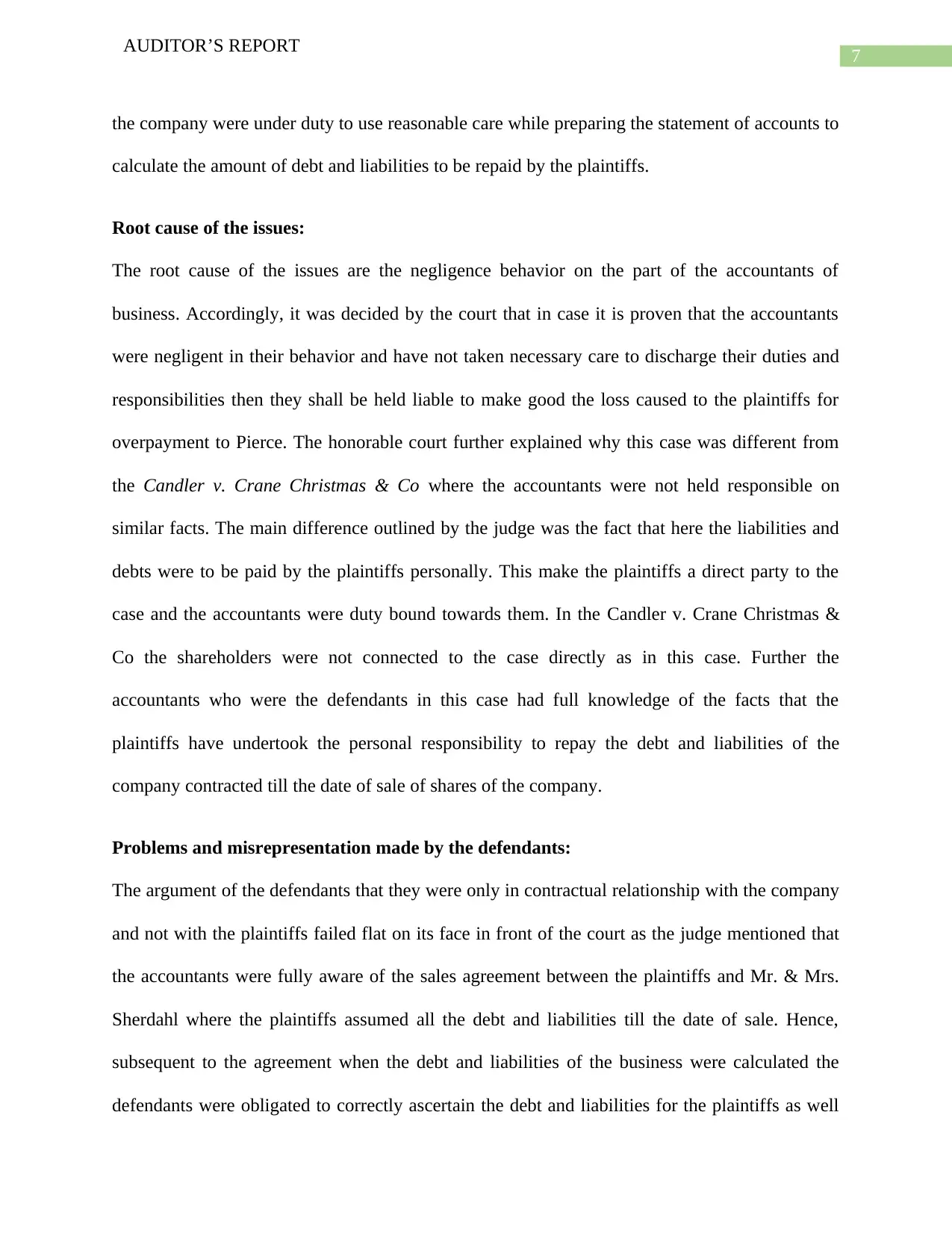
7
AUDITOR’S REPORT
the company were under duty to use reasonable care while preparing the statement of accounts to
calculate the amount of debt and liabilities to be repaid by the plaintiffs.
Root cause of the issues:
The root cause of the issues are the negligence behavior on the part of the accountants of
business. Accordingly, it was decided by the court that in case it is proven that the accountants
were negligent in their behavior and have not taken necessary care to discharge their duties and
responsibilities then they shall be held liable to make good the loss caused to the plaintiffs for
overpayment to Pierce. The honorable court further explained why this case was different from
the Candler v. Crane Christmas & Co where the accountants were not held responsible on
similar facts. The main difference outlined by the judge was the fact that here the liabilities and
debts were to be paid by the plaintiffs personally. This make the plaintiffs a direct party to the
case and the accountants were duty bound towards them. In the Candler v. Crane Christmas &
Co the shareholders were not connected to the case directly as in this case. Further the
accountants who were the defendants in this case had full knowledge of the facts that the
plaintiffs have undertook the personal responsibility to repay the debt and liabilities of the
company contracted till the date of sale of shares of the company.
Problems and misrepresentation made by the defendants:
The argument of the defendants that they were only in contractual relationship with the company
and not with the plaintiffs failed flat on its face in front of the court as the judge mentioned that
the accountants were fully aware of the sales agreement between the plaintiffs and Mr. & Mrs.
Sherdahl where the plaintiffs assumed all the debt and liabilities till the date of sale. Hence,
subsequent to the agreement when the debt and liabilities of the business were calculated the
defendants were obligated to correctly ascertain the debt and liabilities for the plaintiffs as well
AUDITOR’S REPORT
the company were under duty to use reasonable care while preparing the statement of accounts to
calculate the amount of debt and liabilities to be repaid by the plaintiffs.
Root cause of the issues:
The root cause of the issues are the negligence behavior on the part of the accountants of
business. Accordingly, it was decided by the court that in case it is proven that the accountants
were negligent in their behavior and have not taken necessary care to discharge their duties and
responsibilities then they shall be held liable to make good the loss caused to the plaintiffs for
overpayment to Pierce. The honorable court further explained why this case was different from
the Candler v. Crane Christmas & Co where the accountants were not held responsible on
similar facts. The main difference outlined by the judge was the fact that here the liabilities and
debts were to be paid by the plaintiffs personally. This make the plaintiffs a direct party to the
case and the accountants were duty bound towards them. In the Candler v. Crane Christmas &
Co the shareholders were not connected to the case directly as in this case. Further the
accountants who were the defendants in this case had full knowledge of the facts that the
plaintiffs have undertook the personal responsibility to repay the debt and liabilities of the
company contracted till the date of sale of shares of the company.
Problems and misrepresentation made by the defendants:
The argument of the defendants that they were only in contractual relationship with the company
and not with the plaintiffs failed flat on its face in front of the court as the judge mentioned that
the accountants were fully aware of the sales agreement between the plaintiffs and Mr. & Mrs.
Sherdahl where the plaintiffs assumed all the debt and liabilities till the date of sale. Hence,
subsequent to the agreement when the debt and liabilities of the business were calculated the
defendants were obligated to correctly ascertain the debt and liabilities for the plaintiffs as well
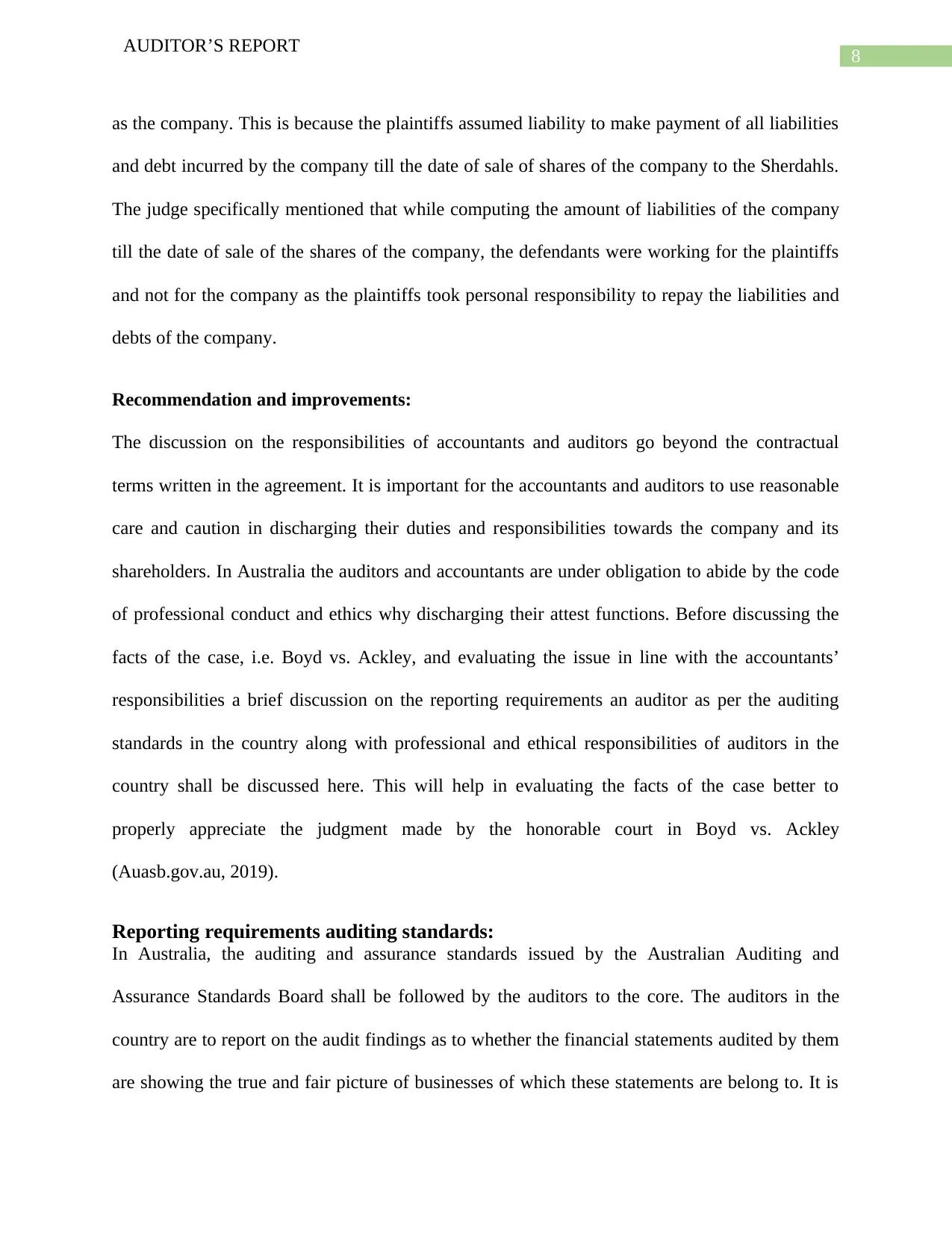
8
AUDITOR’S REPORT
as the company. This is because the plaintiffs assumed liability to make payment of all liabilities
and debt incurred by the company till the date of sale of shares of the company to the Sherdahls.
The judge specifically mentioned that while computing the amount of liabilities of the company
till the date of sale of the shares of the company, the defendants were working for the plaintiffs
and not for the company as the plaintiffs took personal responsibility to repay the liabilities and
debts of the company.
Recommendation and improvements:
The discussion on the responsibilities of accountants and auditors go beyond the contractual
terms written in the agreement. It is important for the accountants and auditors to use reasonable
care and caution in discharging their duties and responsibilities towards the company and its
shareholders. In Australia the auditors and accountants are under obligation to abide by the code
of professional conduct and ethics why discharging their attest functions. Before discussing the
facts of the case, i.e. Boyd vs. Ackley, and evaluating the issue in line with the accountants’
responsibilities a brief discussion on the reporting requirements an auditor as per the auditing
standards in the country along with professional and ethical responsibilities of auditors in the
country shall be discussed here. This will help in evaluating the facts of the case better to
properly appreciate the judgment made by the honorable court in Boyd vs. Ackley
(Auasb.gov.au, 2019).
Reporting requirements auditing standards:
In Australia, the auditing and assurance standards issued by the Australian Auditing and
Assurance Standards Board shall be followed by the auditors to the core. The auditors in the
country are to report on the audit findings as to whether the financial statements audited by them
are showing the true and fair picture of businesses of which these statements are belong to. It is
AUDITOR’S REPORT
as the company. This is because the plaintiffs assumed liability to make payment of all liabilities
and debt incurred by the company till the date of sale of shares of the company to the Sherdahls.
The judge specifically mentioned that while computing the amount of liabilities of the company
till the date of sale of the shares of the company, the defendants were working for the plaintiffs
and not for the company as the plaintiffs took personal responsibility to repay the liabilities and
debts of the company.
Recommendation and improvements:
The discussion on the responsibilities of accountants and auditors go beyond the contractual
terms written in the agreement. It is important for the accountants and auditors to use reasonable
care and caution in discharging their duties and responsibilities towards the company and its
shareholders. In Australia the auditors and accountants are under obligation to abide by the code
of professional conduct and ethics why discharging their attest functions. Before discussing the
facts of the case, i.e. Boyd vs. Ackley, and evaluating the issue in line with the accountants’
responsibilities a brief discussion on the reporting requirements an auditor as per the auditing
standards in the country along with professional and ethical responsibilities of auditors in the
country shall be discussed here. This will help in evaluating the facts of the case better to
properly appreciate the judgment made by the honorable court in Boyd vs. Ackley
(Auasb.gov.au, 2019).
Reporting requirements auditing standards:
In Australia, the auditing and assurance standards issued by the Australian Auditing and
Assurance Standards Board shall be followed by the auditors to the core. The auditors in the
country are to report on the audit findings as to whether the financial statements audited by them
are showing the true and fair picture of businesses of which these statements are belong to. It is
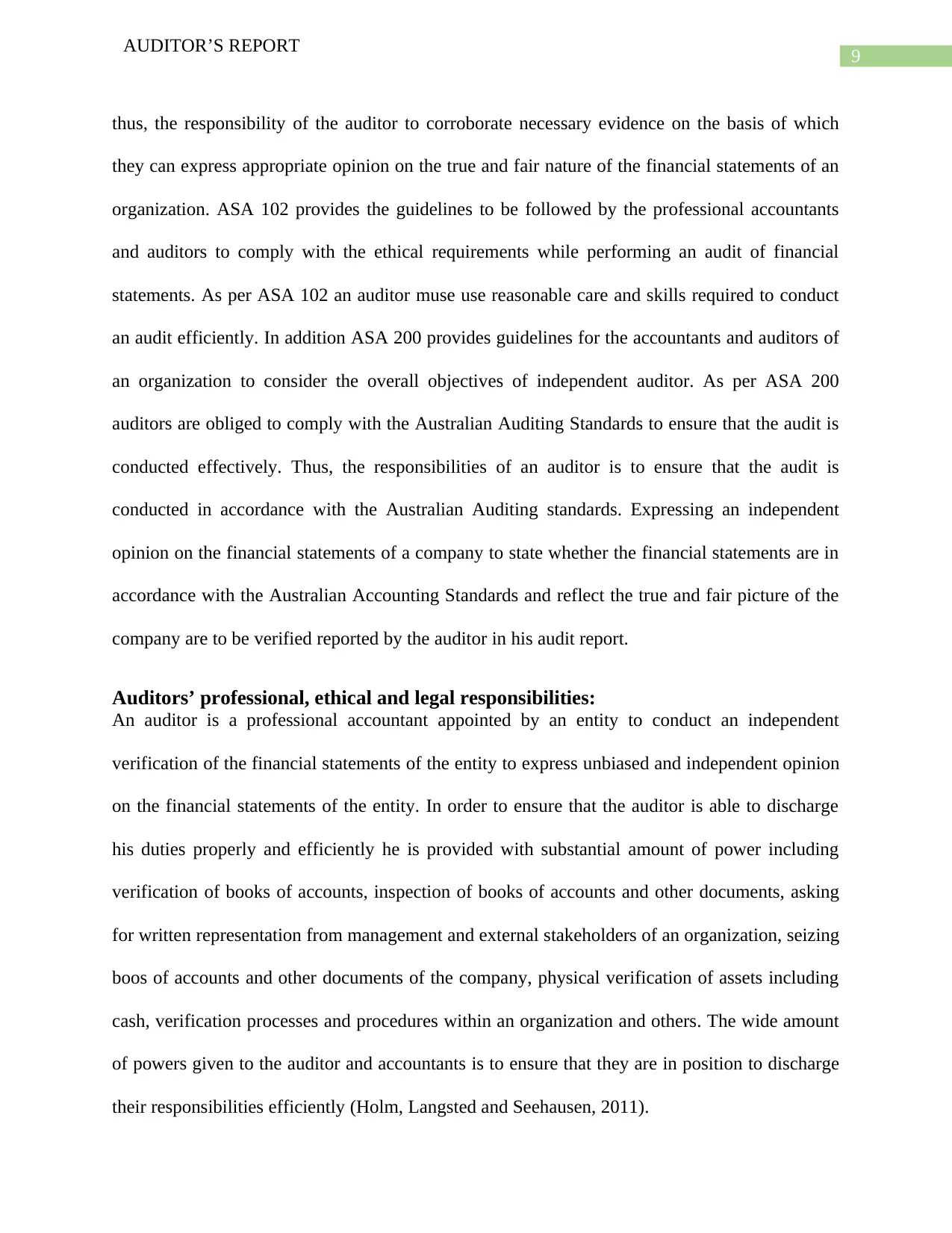
9
AUDITOR’S REPORT
thus, the responsibility of the auditor to corroborate necessary evidence on the basis of which
they can express appropriate opinion on the true and fair nature of the financial statements of an
organization. ASA 102 provides the guidelines to be followed by the professional accountants
and auditors to comply with the ethical requirements while performing an audit of financial
statements. As per ASA 102 an auditor muse use reasonable care and skills required to conduct
an audit efficiently. In addition ASA 200 provides guidelines for the accountants and auditors of
an organization to consider the overall objectives of independent auditor. As per ASA 200
auditors are obliged to comply with the Australian Auditing Standards to ensure that the audit is
conducted effectively. Thus, the responsibilities of an auditor is to ensure that the audit is
conducted in accordance with the Australian Auditing standards. Expressing an independent
opinion on the financial statements of a company to state whether the financial statements are in
accordance with the Australian Accounting Standards and reflect the true and fair picture of the
company are to be verified reported by the auditor in his audit report.
Auditors’ professional, ethical and legal responsibilities:
An auditor is a professional accountant appointed by an entity to conduct an independent
verification of the financial statements of the entity to express unbiased and independent opinion
on the financial statements of the entity. In order to ensure that the auditor is able to discharge
his duties properly and efficiently he is provided with substantial amount of power including
verification of books of accounts, inspection of books of accounts and other documents, asking
for written representation from management and external stakeholders of an organization, seizing
boos of accounts and other documents of the company, physical verification of assets including
cash, verification processes and procedures within an organization and others. The wide amount
of powers given to the auditor and accountants is to ensure that they are in position to discharge
their responsibilities efficiently (Holm, Langsted and Seehausen, 2011).
AUDITOR’S REPORT
thus, the responsibility of the auditor to corroborate necessary evidence on the basis of which
they can express appropriate opinion on the true and fair nature of the financial statements of an
organization. ASA 102 provides the guidelines to be followed by the professional accountants
and auditors to comply with the ethical requirements while performing an audit of financial
statements. As per ASA 102 an auditor muse use reasonable care and skills required to conduct
an audit efficiently. In addition ASA 200 provides guidelines for the accountants and auditors of
an organization to consider the overall objectives of independent auditor. As per ASA 200
auditors are obliged to comply with the Australian Auditing Standards to ensure that the audit is
conducted effectively. Thus, the responsibilities of an auditor is to ensure that the audit is
conducted in accordance with the Australian Auditing standards. Expressing an independent
opinion on the financial statements of a company to state whether the financial statements are in
accordance with the Australian Accounting Standards and reflect the true and fair picture of the
company are to be verified reported by the auditor in his audit report.
Auditors’ professional, ethical and legal responsibilities:
An auditor is a professional accountant appointed by an entity to conduct an independent
verification of the financial statements of the entity to express unbiased and independent opinion
on the financial statements of the entity. In order to ensure that the auditor is able to discharge
his duties properly and efficiently he is provided with substantial amount of power including
verification of books of accounts, inspection of books of accounts and other documents, asking
for written representation from management and external stakeholders of an organization, seizing
boos of accounts and other documents of the company, physical verification of assets including
cash, verification processes and procedures within an organization and others. The wide amount
of powers given to the auditor and accountants is to ensure that they are in position to discharge
their responsibilities efficiently (Holm, Langsted and Seehausen, 2011).
Secure Best Marks with AI Grader
Need help grading? Try our AI Grader for instant feedback on your assignments.
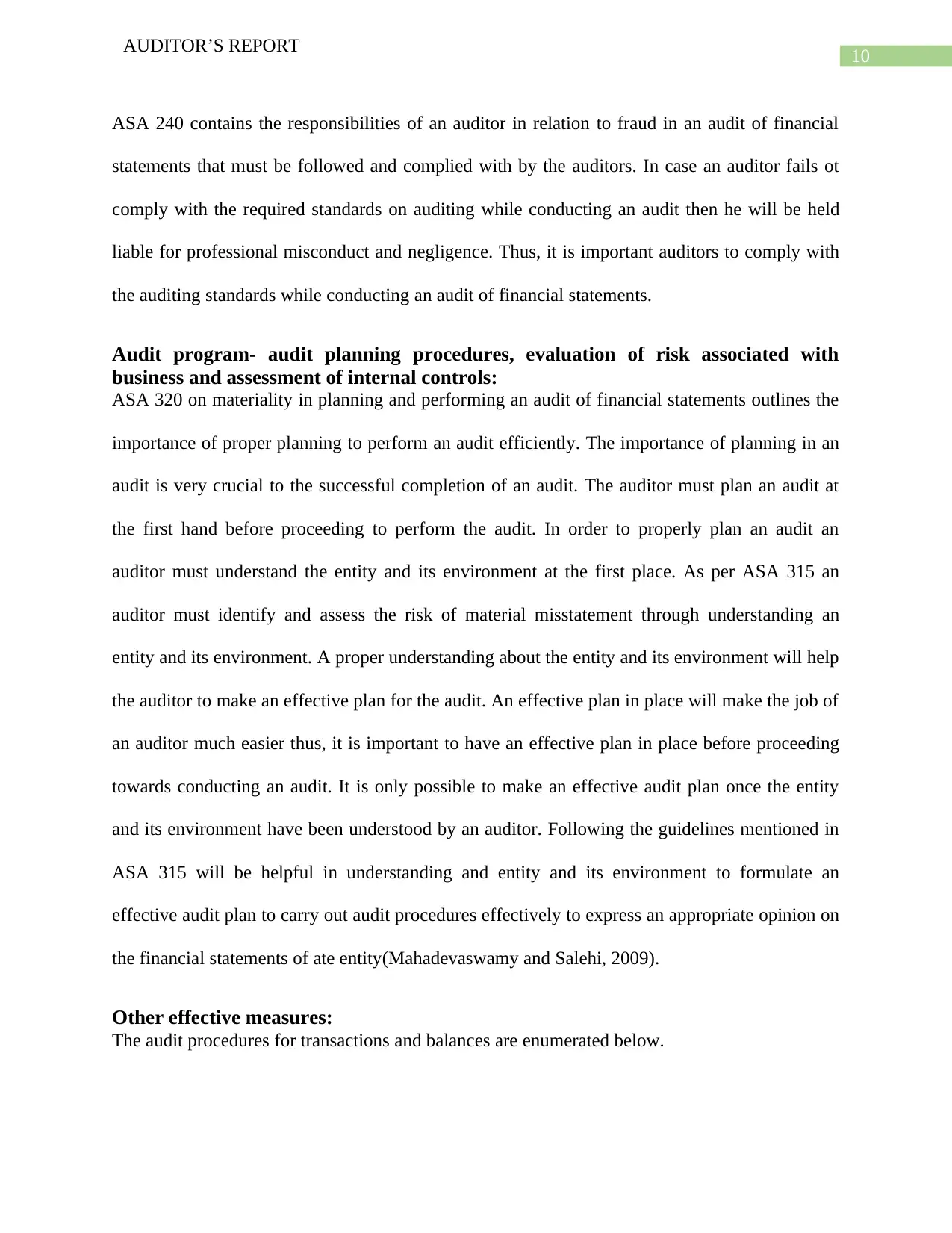
10
AUDITOR’S REPORT
ASA 240 contains the responsibilities of an auditor in relation to fraud in an audit of financial
statements that must be followed and complied with by the auditors. In case an auditor fails ot
comply with the required standards on auditing while conducting an audit then he will be held
liable for professional misconduct and negligence. Thus, it is important auditors to comply with
the auditing standards while conducting an audit of financial statements.
Audit program- audit planning procedures, evaluation of risk associated with
business and assessment of internal controls:
ASA 320 on materiality in planning and performing an audit of financial statements outlines the
importance of proper planning to perform an audit efficiently. The importance of planning in an
audit is very crucial to the successful completion of an audit. The auditor must plan an audit at
the first hand before proceeding to perform the audit. In order to properly plan an audit an
auditor must understand the entity and its environment at the first place. As per ASA 315 an
auditor must identify and assess the risk of material misstatement through understanding an
entity and its environment. A proper understanding about the entity and its environment will help
the auditor to make an effective plan for the audit. An effective plan in place will make the job of
an auditor much easier thus, it is important to have an effective plan in place before proceeding
towards conducting an audit. It is only possible to make an effective audit plan once the entity
and its environment have been understood by an auditor. Following the guidelines mentioned in
ASA 315 will be helpful in understanding and entity and its environment to formulate an
effective audit plan to carry out audit procedures effectively to express an appropriate opinion on
the financial statements of ate entity(Mahadevaswamy and Salehi, 2009).
Other effective measures:
The audit procedures for transactions and balances are enumerated below.
AUDITOR’S REPORT
ASA 240 contains the responsibilities of an auditor in relation to fraud in an audit of financial
statements that must be followed and complied with by the auditors. In case an auditor fails ot
comply with the required standards on auditing while conducting an audit then he will be held
liable for professional misconduct and negligence. Thus, it is important auditors to comply with
the auditing standards while conducting an audit of financial statements.
Audit program- audit planning procedures, evaluation of risk associated with
business and assessment of internal controls:
ASA 320 on materiality in planning and performing an audit of financial statements outlines the
importance of proper planning to perform an audit efficiently. The importance of planning in an
audit is very crucial to the successful completion of an audit. The auditor must plan an audit at
the first hand before proceeding to perform the audit. In order to properly plan an audit an
auditor must understand the entity and its environment at the first place. As per ASA 315 an
auditor must identify and assess the risk of material misstatement through understanding an
entity and its environment. A proper understanding about the entity and its environment will help
the auditor to make an effective plan for the audit. An effective plan in place will make the job of
an auditor much easier thus, it is important to have an effective plan in place before proceeding
towards conducting an audit. It is only possible to make an effective audit plan once the entity
and its environment have been understood by an auditor. Following the guidelines mentioned in
ASA 315 will be helpful in understanding and entity and its environment to formulate an
effective audit plan to carry out audit procedures effectively to express an appropriate opinion on
the financial statements of ate entity(Mahadevaswamy and Salehi, 2009).
Other effective measures:
The audit procedures for transactions and balances are enumerated below.
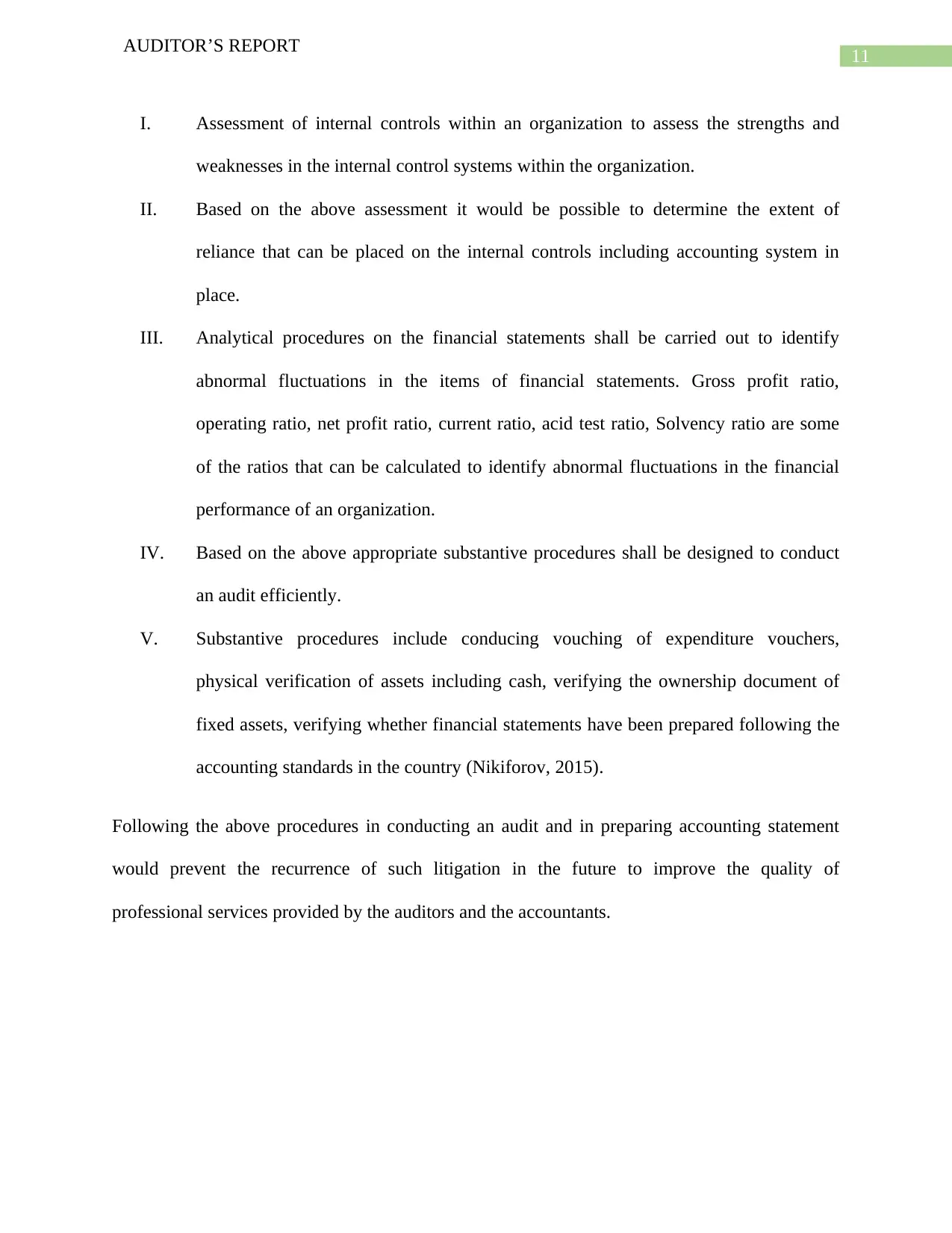
11
AUDITOR’S REPORT
I. Assessment of internal controls within an organization to assess the strengths and
weaknesses in the internal control systems within the organization.
II. Based on the above assessment it would be possible to determine the extent of
reliance that can be placed on the internal controls including accounting system in
place.
III. Analytical procedures on the financial statements shall be carried out to identify
abnormal fluctuations in the items of financial statements. Gross profit ratio,
operating ratio, net profit ratio, current ratio, acid test ratio, Solvency ratio are some
of the ratios that can be calculated to identify abnormal fluctuations in the financial
performance of an organization.
IV. Based on the above appropriate substantive procedures shall be designed to conduct
an audit efficiently.
V. Substantive procedures include conducing vouching of expenditure vouchers,
physical verification of assets including cash, verifying the ownership document of
fixed assets, verifying whether financial statements have been prepared following the
accounting standards in the country (Nikiforov, 2015).
Following the above procedures in conducting an audit and in preparing accounting statement
would prevent the recurrence of such litigation in the future to improve the quality of
professional services provided by the auditors and the accountants.
AUDITOR’S REPORT
I. Assessment of internal controls within an organization to assess the strengths and
weaknesses in the internal control systems within the organization.
II. Based on the above assessment it would be possible to determine the extent of
reliance that can be placed on the internal controls including accounting system in
place.
III. Analytical procedures on the financial statements shall be carried out to identify
abnormal fluctuations in the items of financial statements. Gross profit ratio,
operating ratio, net profit ratio, current ratio, acid test ratio, Solvency ratio are some
of the ratios that can be calculated to identify abnormal fluctuations in the financial
performance of an organization.
IV. Based on the above appropriate substantive procedures shall be designed to conduct
an audit efficiently.
V. Substantive procedures include conducing vouching of expenditure vouchers,
physical verification of assets including cash, verifying the ownership document of
fixed assets, verifying whether financial statements have been prepared following the
accounting standards in the country (Nikiforov, 2015).
Following the above procedures in conducting an audit and in preparing accounting statement
would prevent the recurrence of such litigation in the future to improve the quality of
professional services provided by the auditors and the accountants.
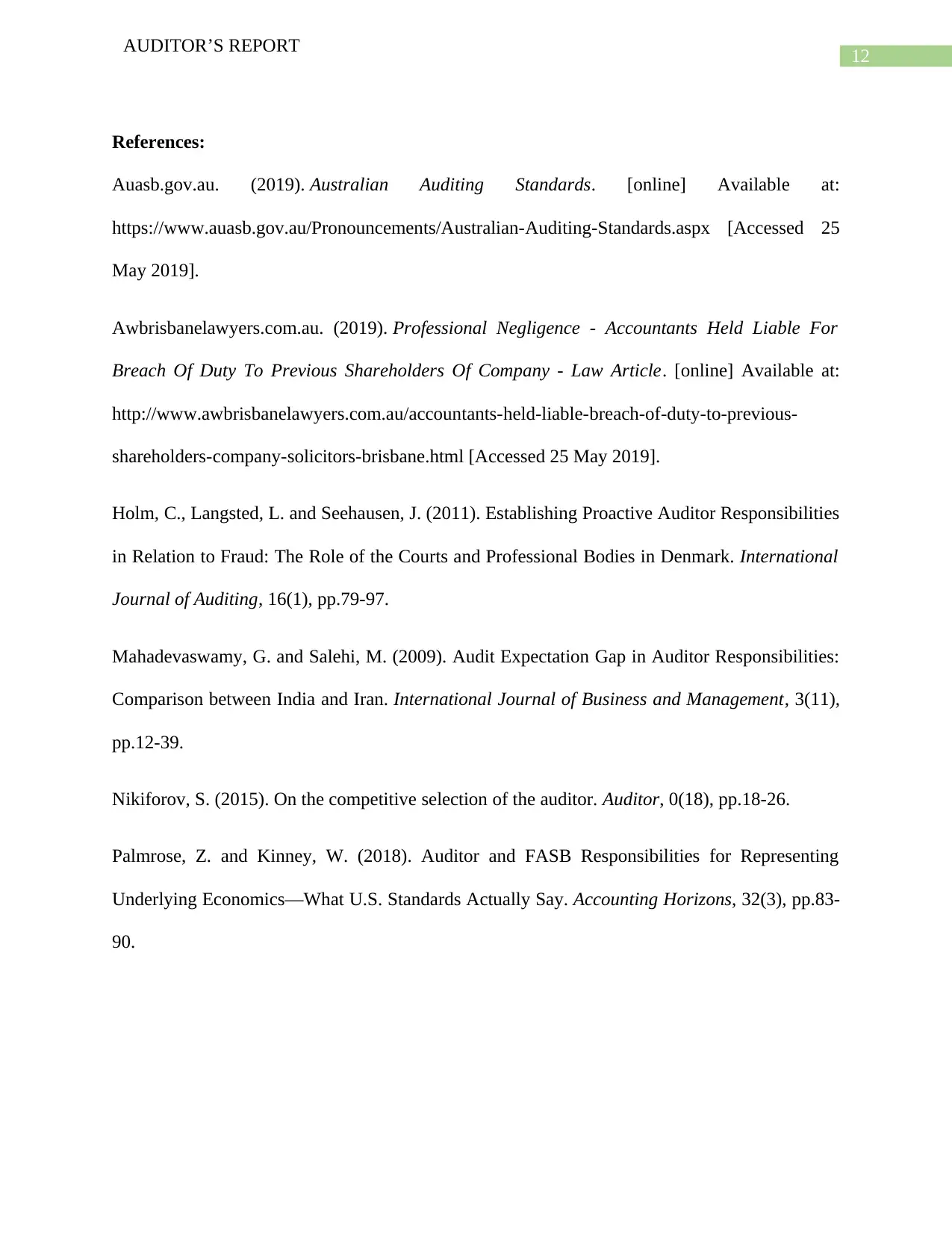
12
AUDITOR’S REPORT
References:
Auasb.gov.au. (2019). Australian Auditing Standards. [online] Available at:
https://www.auasb.gov.au/Pronouncements/Australian-Auditing-Standards.aspx [Accessed 25
May 2019].
Awbrisbanelawyers.com.au. (2019). Professional Negligence - Accountants Held Liable For
Breach Of Duty To Previous Shareholders Of Company - Law Article. [online] Available at:
http://www.awbrisbanelawyers.com.au/accountants-held-liable-breach-of-duty-to-previous-
shareholders-company-solicitors-brisbane.html [Accessed 25 May 2019].
Holm, C., Langsted, L. and Seehausen, J. (2011). Establishing Proactive Auditor Responsibilities
in Relation to Fraud: The Role of the Courts and Professional Bodies in Denmark. International
Journal of Auditing, 16(1), pp.79-97.
Mahadevaswamy, G. and Salehi, M. (2009). Audit Expectation Gap in Auditor Responsibilities:
Comparison between India and Iran. International Journal of Business and Management, 3(11),
pp.12-39.
Nikiforov, S. (2015). On the competitive selection of the auditor. Auditor, 0(18), pp.18-26.
Palmrose, Z. and Kinney, W. (2018). Auditor and FASB Responsibilities for Representing
Underlying Economics—What U.S. Standards Actually Say. Accounting Horizons, 32(3), pp.83-
90.
AUDITOR’S REPORT
References:
Auasb.gov.au. (2019). Australian Auditing Standards. [online] Available at:
https://www.auasb.gov.au/Pronouncements/Australian-Auditing-Standards.aspx [Accessed 25
May 2019].
Awbrisbanelawyers.com.au. (2019). Professional Negligence - Accountants Held Liable For
Breach Of Duty To Previous Shareholders Of Company - Law Article. [online] Available at:
http://www.awbrisbanelawyers.com.au/accountants-held-liable-breach-of-duty-to-previous-
shareholders-company-solicitors-brisbane.html [Accessed 25 May 2019].
Holm, C., Langsted, L. and Seehausen, J. (2011). Establishing Proactive Auditor Responsibilities
in Relation to Fraud: The Role of the Courts and Professional Bodies in Denmark. International
Journal of Auditing, 16(1), pp.79-97.
Mahadevaswamy, G. and Salehi, M. (2009). Audit Expectation Gap in Auditor Responsibilities:
Comparison between India and Iran. International Journal of Business and Management, 3(11),
pp.12-39.
Nikiforov, S. (2015). On the competitive selection of the auditor. Auditor, 0(18), pp.18-26.
Palmrose, Z. and Kinney, W. (2018). Auditor and FASB Responsibilities for Representing
Underlying Economics—What U.S. Standards Actually Say. Accounting Horizons, 32(3), pp.83-
90.
Paraphrase This Document
Need a fresh take? Get an instant paraphrase of this document with our AI Paraphraser

13
AUDITOR’S REPORT
AUDITOR’S REPORT
1 out of 14
Related Documents
Your All-in-One AI-Powered Toolkit for Academic Success.
+13062052269
info@desklib.com
Available 24*7 on WhatsApp / Email
![[object Object]](/_next/static/media/star-bottom.7253800d.svg)
Unlock your academic potential
© 2024 | Zucol Services PVT LTD | All rights reserved.





